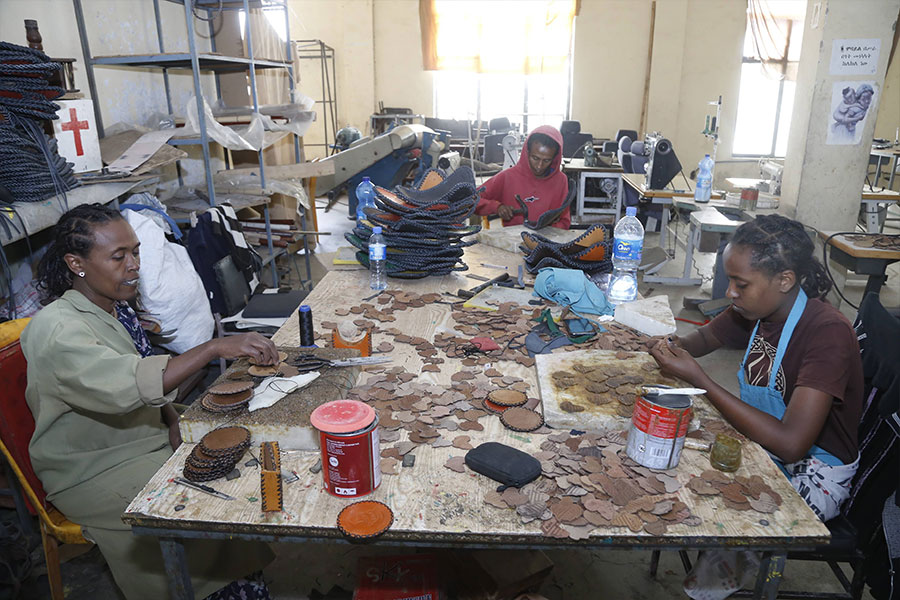
Radar | Jan 19,2024
On the road to Debre Berhan lies the small town of Chacha. Bordering the Oromia Regional State with the Amhara Regional States, Chacha is home to a couple of relatively large factories. One of them, incorporated in 2009 with an initial capital of 1.5 million Br, can process up to 25,000 litres of pasteurised milk a day. The plant rests on a 1,200sqm land 110Km northeast of Addis Abeba and operates with 25 permanent employees.
Last week, half of the workers were on duty, manning three separate production lines.
Shambel Zegaye, the company's production manager, stood quietly, supervising four employees assigned to the pasteurisation process. Dressed in layers and wearing leather boots with hard soles, these workers heated milk for no less than 15 seconds. The heat exchangers they use destroy harmful bacteria and microorganisms. They carried out their task in a relaxed manner, constantly chatting.
The Production Manager saw no reason to tell them off.
"The milk we receive is little," he told Fortune. "There's no need to hurry."
The company sources 90pc of the raw milk it processes from smallholder farmers and cooperative unions in the area. Things have gotten not so good lately. The days when it sourced a fifth of its demand are now considered good. It is an outcome the founders of Hirut & Ruth Milk Processing Plc did not envision when they borrowed 17 million Br from a commercial bank two years ago. Getting milk supplies from the surrounding areas, considered rich in cattle population, was their least worries when launching Tsega Milk.
"We're struggling to service our loans,” said Hirut Yohannes, a major shareholder of the company.
Like Hirut's company, almost all of the 40 milk processors face a crippling shortage in milk supply. Combined, these companies have a processing capacity of 200,000lt of milk a day. It was double the capacity recorded five years ago.
Lame Dairy is one of the 70 subsidiaries of MIDROC Ethiopia Investment Group. It acquired a milk processing plant, Dairy Products Development Enterprise, from the state in 2007 for 62 million Br, with its popular brand, Shola Milk. It doubled production capacity by expanding its facility in the Gurd Shola area, in recent years, to 10,000lt an hour. The processing plant it imported from Italy consumed a four million euros investment. It has proven to be an expansion in vain.
The volume of milk it can pack in an hour is done in three days. Not much can be sourced from areas the company depends on for supply in Debre Birhan, Fiche, Sendafa, Melke Turi and Holeta.
Getting milk supplies from the surrounding areas has been challenging for the 40 milk processors in the country, including Hirut & Ruth Milk Processing Plc, which operates with 25 employees.
Milk is sold directly to processors or cooperatives. Except in a few areas where dairy producers are organised into milk marketing cooperatives, it is predominantly supplied through informal channels where raw milk is sold on a contractual basis. Unavailability of support services such as cooling facilities, transportation and erratic electric supplies is believed to have favoured the informal market, where milk is sold to neighbours or processed into butter and cheese.
Industry players note supply shortages are not uncommon, as demand has always exceeded supply. However, the issue has become more pressing in the last month, pushing prices upward.
In the past few weeks, retail prices for half a litre of pasteurised milk in the capital have jumped by at least 20 Br to 45 Br. Half a litre of yoghurt shot up by 12 Br to around 45 Br.
The authorities have observed the supply issues plaguing the industry, despite the growth in processing capacity. They saw plants forced to shut down one after the other due to severe shortages in supply.
“We don't know how many companies are actively operating at the moment,” said Asmelash Berhe, director of milk resource development at the Ministry of Agriculture.
Dairy production has been a subsistence smallholder-based industry with relatively few small and medium commercial dairy farms. Yet, Ethiopia boasts one of the highest livestock populations in Africa, estimated to be around 58 million cattle. Around a fifth are dairy cows. The latest survey conducted by the Ethiopian Statistics Service reveals last year's production stood at 4.1 billion litres of milk. It is a fifth lower than neighbouring Kenya, with a significantly lower cattle population.
Milk production has been growing by an estimated four percent annually, though consumption has dropped. It is down to 19lt per person annually, down from an average of 22lt over the past 25 years.
Dairy products can be categorised into mixed crop-livestock, pastoral, specialised urban, and peri-urban production systems. The pastoral system depends on indigenous breeds, managed under extensive rangeland grazing. Farmers predominantly keep indigenous breeds that are resilient but offer lower volume than foreign breeds.
The low productivity of domestic cow breeds and the city's ever-growing population have been compounding factors. Hirut & Ruth Milk Processing Plc used to buy a litre of milk at 28 Br a month ago. It has since jumped to 33 Br.
“Few farmers in this area are engaged in animal husbandry,” said Shambel.
The latest survey conducted by the Ethiopian Statistics Service reveals last year's production stood at 4.1 billion litres of milk.
Desta Gebrekidan, a mother of three, is one of the farmers who supply milk to the company. She depends on the cross-breed cow bought five years ago with 30,000 Br. It can yield up to 10lt of milk a day, a far cry compared to the global average of 34lt.
Almost all of the cows in Ethiopia are indigenous breeds that can produce a maximum of 1.5 litres of milk a day. On the contrary, cross-breeds can produce up to 10lt while exotic cows give up to 40lt. Programs to bring up productivity have yet to yield.
Efforts to increase milk production through cross-breeding and artificial insemination have been unsuccessful, argued Negassie Ameha (PhD), animal science lecturer at Haromaya University. He blames the lack of research centres to facilitate the process as a major impediment. The Holeta Agricultural Research Institute is lone in experimenting with cross-breeding and artificial insemination.
Although cross-bred cows produce a higher volume of milk, industry players say the quality of their produce is inadequate to the indigenous ones.
Hoping to increase milk production and earn more money, Desta spent heavily on cattle feed, which costs around 3,000 Br a quintal. A quintal of feed was 1,150 Br a year ago.
“I've no choice except to increase the milk price,” she said.
She spends up to 10,000 Br a month on feed, determined to keep her cow producing milk during the dry season. The time between December and June is when the pasture shrinks. This is also when farmers turn to chaff (Furushka in the local parlance), made from wheat, rice, sorghum, or combination. Prices have more than doubled in the past year, forcing those in the value chain to make adjustments.
Animal feed providers, particularly those that sell chaff, blame the rapid rise in prices on the shortage of by-products they get from flour factories. They insist that the shortage of wheat is the culprit.
Wheat shortages have been a pressing issue for the past decade, growing worse over the last couple of years. The federal government has been attempting to address the problems through imports, which have nearly tripled to 1.7 million tonnes annually over the last 10 years. Ethiopia covers a third of its wheat consumption through imports.
Desta has raised prices for her milk twice over the last year, most recently by five Birr a litre.
Dairy plants such as Hirut & Ruth Milk Processing did the same; they increased prices for their packaged milk by 10 Br a litre.
Prices for other dairy products have gone up, too. A kilo of cheese retails for 200 Br on average in the capital, a quarter more expensive than a month ago.
The dairy industry's problems go beyond supply shortfalls.
It has become common to see dairy farmers or traders deliberately adulterate milk. Water is the most commonly used to dilute the milk, often added to increase volume for economic gain.
“The problem is severe,” Asmelash admitted.
Industry players say the nutritional quality of milk products is below standard due to poor hygienic practices and water adulteration at farms and by value chain actors.
“We've encountered some suppliers adding a lot of water to the milk,” said Desalegn.
He says his plant rejects the milk if the laboratory tests show signs of adulteration.
The Ethiopian Standards Agency (ESA) has developed microbial and contaminant standards to ensure the milk quality available to the market. However, the Agency is only mandated to set the standards, according to Yilma Mengistu, standard development director at the Agency.
The Ethiopian Food & Drug Authority (EFDA) is the sole agency in charge of the safety, quality and efficacy of medicines and food items. The newly-formed Animal Development Institute is to be tasked with the responsibility of ensuring milk quality and safety. It will be operating under the Ministry of Agriculture. A proclamation that gives the Institute a larger purview is under preparation, according to Asmelash.
“We've established a team to start conducting research and identify the gaps observed in the industry,” he said.
PUBLISHED ON
Jun 07,2022 [ VOL
23 , NO
1154]

Radar | Jan 19,2024

Fortune News | Jun 20,2020

Sponsored Contents | Nov 28,2024


Commentaries | Jan 26,2019

Radar | May 24,2025

Agenda | Apr 09,2022

Fortune News | Apr 28,2024

In-Picture | May 12,2024

Radar | Nov 27,2023

Dec 22 , 2024 . By TIZITA SHEWAFERAW
Charged with transforming colossal state-owned enterprises into modern and competitiv...

Aug 18 , 2024 . By AKSAH ITALO
Although predictable Yonas Zerihun's job in the ride-hailing service is not immune to...

Jul 28 , 2024 . By TIZITA SHEWAFERAW
Unhabitual, perhaps too many, Samuel Gebreyohannes, 38, used to occasionally enjoy a couple of beers at breakfast. However, he recently swit...

Jul 13 , 2024 . By AKSAH ITALO
Investors who rely on tractors, trucks, and field vehicles for commuting, transporting commodities, and f...

Jul 5 , 2025
Six years ago, Ethiopia was the darling of international liberal commentators. A year...

Jun 28 , 2025
Meseret Damtie, the assertive auditor general, has never been shy about naming names...

Jun 21 , 2025
A well-worn adage says, “Budget is not destiny, but it is direction.” Examining t...

Jun 14 , 2025
Yet again, the Horn of Africa is bracing for trouble. A region already frayed by wars...